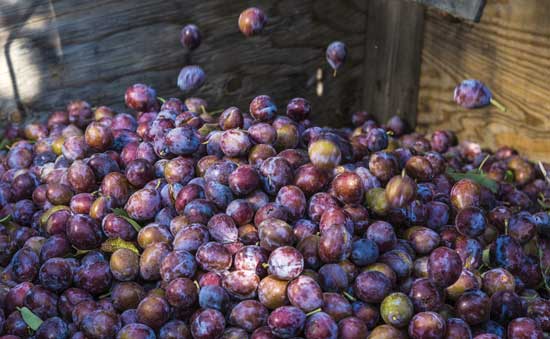Prunes: No Longer a Laughing Matter
FOOD, MEDICINE & HEALTH
 It’s time to replace prune jokes with a riddle: If all prunes are plums, are all plums prunes? The short answer is no. The prune plum is a specific cultivar, Prunus domestica L. cv d’Agen, with specific characteristics. Based on their nutrient profile and demonstrated health benefits, prunes certainly are no longer a laughing matter.
It’s time to replace prune jokes with a riddle: If all prunes are plums, are all plums prunes? The short answer is no. The prune plum is a specific cultivar, Prunus domestica L. cv d’Agen, with specific characteristics. Based on their nutrient profile and demonstrated health benefits, prunes certainly are no longer a laughing matter.
Agriculturist brothers Louis and Pierre Pellier brought the Petite d’Agen plum from France to California during the Gold Rush and grafted it onto wild American plum stock. These prune plums ripen fully on the tree, pit and all, without fermenting due to their naturally occurring high fruit sugar content. Today, California—with about 46,000 acres of prune plum trees, primarily in the Sacramento and San Joaquin Valleys—produces approximately 99% of the U.S. supply of prunes and 40% of the world’s supply. The U.S. Food and Drug Administration approved the use of the descriptor “dried plums” in 2001 based on research that consumers responded more favorably to the name; internationally, however, prunes continue to be called prunes. California prunes are distributed throughout the world; key markets include Japan, the European Union, Canada, China, South Korea, and Southeast Asia.
Dormant in winter, the prune plum tree blossoms in the spring and is harvested mechanically beginning mid-August when the desirable sugar content has been determined through instrumentation. Under strict sanitary and temperature-controlled conditions, the harvested fruit is taken by conveyor to the dehydrator, where it is washed and where three pounds of fresh fruit yield one pound dried product. Packed to order, dried plums are rehydrated, sterilized, inspected again, and packaged for various uses. Culinarians and foodies appreciate not only the health benefits but also the great taste, texture, flavor, and functionality of dried plums, which can substitute for fat in baking and enhance the moisture and taste in meat applications from hamburgers and beyond. Chefs at white-tablecloth restaurants offer cutting-edge menu features, such as dried plum and walnut phyllo triangles or roast duck with dried plum and ancho chile port-wine sauce. Chocolatiers use prunes to develop high quality chocolates for the confectionery market.
Fruit and vegetable intakes were the only dietary characteristic consistently associated with every conclusion statement across health outcomes in the 2015 U.S. Dietary Guidelines Advisory Committee report. Yet national estimates indicate fruit consumption is less than 1 cup a day (CDC 2015) for much of the population. This suggests that increasing fruit consumption is an opportunity to add under- consumed nutrients such as fiber and potassium to the diet.
A serving of dried plums/prunes is 4–5, based on a 40 g Reference Amount Customarily Consumed (FDA 2017). For fewer than 100 calories, prunes are a good source of dietary fiber (3 g/11% DV) and copper (0.1 mg/10% DV) and an excellent source of vitamin K (23 mcg/20% DV). Prunes also have potassium, riboflavin, niacin, B6, pantothenic acid, magnesium, and manganese that when eaten consistently contribute to improved nutrient intake (USDA 2017). Prunes’ naturally occurring fruit sugars include fructose, glucose, and very little sucrose, which is hydrolyzed during drying (Stacewicz-Sapuntzakis 2013). The U.S. Dept. of Agriculture National Nutrient Database for Standard Reference Release 28 does not include values for sorbitol, but a previous publication reported 12 g per 100 g (Stacewicz-Sapuntzakis 2013). Prunes are considered a low glycemic index food (GI = 29 ± 4), possibly due to the combination of innate sorbitol and dietary fiber (Foster-Powell et al. 2002).
Although long associated with digestive health, little scientific information documented this function until results of a clinical trial discovered dried plums to be more effective than psyllium (matched for dietary fiber) for occasional presentation of mild to moderate constipation (Attaluri et al. 2011). This research helped secure the European Food Safety Authority (EFSA) claim for 100 g daily consumption of dried plums and maintenance of normal bowel function by the general population (EFSA 2012).
Dried plum benefits in digestive health beyond laxation is an active area of research. In a model of chemically induced carcinogenesis, rats consuming dried plum powder had significantly reduced numbers of aberrant crypts and aberrant crypt foci compared with rats fed a control diet (Seidel et al. 2015). Additional research is needed to determine whether the precancerous lesions advance to the tumor state as well as any effect on changes in the gut microbiota.
A combination of observational, experimental, clinical, and intervention studies points to a positive link between fruit and vegetable consumption and indexes of bone health (Lanham-New 2006). Initially identified within older age groups, studies have shown the link in relation to peak bone mass acquisition (Tylavsky et al. 2004). An international review discovered that dietary patterns that emphasized fruits, vegetables, whole grains, poultry and fish, nuts and legumes, and lowfat dairy products and de-emphasized soft drinks, fried foods, meat and processed products, sweets and desserts, and refined grains showed a beneficial impact on bone health (Movassagh and Vatanparast 2017). A healthful diet supports bone health through multiple mechanisms combined with known and yet to be identified dietary components acting in a synergistic manner.
Dried plums’ nutrients associated with bone health— potassium, magnesium, vitamin K, boron, and bioactive compounds (polyphenols)—have sparked research. Dried plums’ ability to possibly reduce bone loss in postmenopausal women, restore bone in animal models of hormone deficiency and aging, and increase bone volume and attain peak bone mass in animals may be related to this nutrient profile and polyphenol content potentially acting as antioxidant and/or anti-inflammatory agent(s) that may reduce bone breakdown at the cellular level through modulation of osteoblast and osteoclast activities (Shahnazari et al. 2016).
A small clinical trial with postmenopausal women randomly assigned to consume either 100 g dried plums or 75 g dried apples (matched for calories, fat, carbohydrate, and fiber) for three months assessed biochemical markers of bone status before and after intervention. Participants also received calcium and vitamin D supplements. Compared to baseline, only dried plums significantly increased serum levels of insulin-like growth factor-I (IGF-I) and bone-specific alkaline phosphatase activity associated with bone formation, although markers of bone resporption were not affected by either intervention (Arjmandi et al 2002). In a 1-year study with postmenopausal women, 100 g (10–12) dried plums produced increases in bone mineral density of the ulna and lumbar spine (Hooshmand et al. 2011). Recent research discovered that daily consumption of 50 g (5–6) dried plums for 6 mo may be as effective as 100 g in reducing bone loss in older, osteopenic postmenopausal women (Hooshmand et al. 2016).
An intriguing finding in the area of bone research relates to dried plums’ apparent ability to protect against increased oxidative damage upon exposure to ionizing radiation, such as that experienced by radiotherapy patients and astronauts at risk for increased bone loss due to weightlessness in space. Animal research that looked at the effect of various antioxidant or anti-inflammatory interventions [an antioxidant cocktail, ibuprofen (anti-inflammatory), dried plum powder (antioxidant), and a control] on mice that received radiation, discovered that mice on the dried plum diet did not lose bone volume in any of the bone structural parameters measured (Schreurs et al. 2016).
The California Dried Plum Board (CaliforniaDriedPlums.org) continues to support nutrition research to improve the nutrient quality of consumers’ food choices and to discover the potential functional and health benefits of prunes’ spectrum of nutrients and possible bioactives. These efforts include the following initiatives: a larger 1-year clinical trial in postmenopausal women investigating the effect of 50 g and 100 g doses of dried plums on bone density, structure, and estimated bone strength; a 6-month clinical trial investigating the effect of 100 g of dried plums on select biomarkers of bone status in men; and an animal study investigating the potential chemoprotective effects of dried plums on colon carcinogenesis.
 Roger Clemens, DrPH, CFS, Contributing Editor
Roger Clemens, DrPH, CFS, Contributing Editor
Adjunct Professor, Univ. of Southern California School of Pharmacy, Los Angeles, Calif.
[email protected]
Mary Jo Feeney, RD, is a consultant to the food and agriculture industries.
